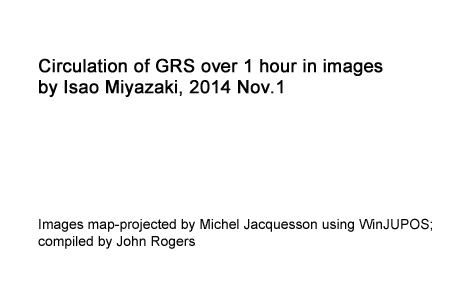[2]
Circulation of the GRS observed even more closely (2014, Dec 2nd.)
GRS
circulation observed even more closely
The
Great Red Spot, now at L2 = 220, is still strongly reddish and exceptionally
small, only 14.2 deg long and 9.1 deg wide (+/-0.4 deg) (2014 Oct-Nov.),
although it now has complex dark streaks around it.
Earlier
this year we measured the internal circulation of the GRS from amateur images,
and found exceptionally short rotation periods of 3.6 days in 2014 Jan. (our
report no.7) and 3.6—3.8 days in 2014 Feb. (M. Jacquesson, unpublished).
A similar analysis of images in 2014 Nov. by M. Jacquesson confirms a rotation
period of 3.8 days. Moreover, the motions within the GRS can be seen
within less than an hour in images on Nov.1.
The internal rotation was
revealed by a dark spot near the edge of the GRS as shown in the attached
image file. All images were map-projected and then stretched to make the GRS
approximately circular for measuring the position angle, as usual. A
single dark spot was clearly tracked from Nov.2-13, with P = 3.78 (+/-0.3)
days. A similar dark spot was also present on the same track on
Nov.18-19, but it was absent on Nov.15, so we cannot be sure if it was
temporarily obscured or replaced by a new feature.
The attached animation shows
something even more special: the internal rotation of the GRS tracked during a
single passage across the disk in 3 images by Isao Miyazaki on Nov.1.
This has never before been achieved from ground-based images. The
circulation is clearly visible over the first, 47-minute interval, and to a
lesser degree over the second, 15-minute interval! Moreover, the
sinuous blue-grey streak in the p. ansa appears to be twisting tighter over
this timescale, as the dark patch at its centre (marked O in the first frame)
remains more-or-less stationary. Ten hours later, this feature had
become the dark spot which we then tracked.
The detection of these phenomena
on Nov.1 was due not only to the excellence of Miyazaki’s images, but also
to the fortunate occurrence of dynamic, high-contrast features in the GRS at
that time. Those of you who can obtain v-hi-res images may likewise be
able to capture the rotation of the GRS during a single passage across the
disk – and perhaps even more dynamic phenomena.
John Rogers & Michel
Jacquesson
2014 Dec.2


_______________________________
John H. Rogers, Ph.D.
Jupiter Section Director,
British Astronomical Association
John H. Rogers, Ph.D. Jupiter Section Director,
British Astronomical Association
jhr11@cam.ac.uk
http://www.britastro.org/jupiter/